With few exceptions, microphones today are more or less inspired by german classics which were released in the 1950’s and 60’s. With a few exceptions... Here is one: The Crowley & Tripp El Diablo, a kind of revolution in the small world of ribbon microphones. Let’s review it!
A little history…
 |
Crowley & Tripp is a newcomer in the audio world. Founded in 2004, the company has its background in medical acoustic research and has started to work in the audio domain using the same technical skills. Bob Crowley and Hugh Tripp have developed their own technologies, building ribbon microphones, with one word in mind: originality. Among their creations, the Naked Eye has been really successful, particularly in the USA.
Crowley & Tripp’s most recent microphone, El Diablo is also their most innovative product. Instead of aluminum or duraluminum, the ribbon is made of a special Roswellite Advanced Material, engineered with nanoscaled structures, such as carbon nanotubes.
 |
This technology tackles the main shortcoming of a ribbon mic: its fragility. Actually, a ribbon mic has two enemies: the phantom power and the higher sound pressure levels (SPL). Even if some ribbon mics have succeeded in managing the phantom power issue, they still have problems with SPL. Usually, a ribbon mic that has been submitted to a high SPL is at risk of being damaged.
Conceived in partnership with the famous Mercenary Audio’s “Fletcher”, the El Diablo specifications were simple: create an extreme SPL capable ribbon microphone. One of the challenge was to make it ideal for bass drum recording…
Such a mic needs exceptional test conditions. We were lucky enough to access the pro environment Studio de la Reine, and benefit from the golden ears of its residents: Laurent, François and Jérémy. We “tortured” the El Diablo in the 30m2 live room, whose acoustical treatment has been designed by Jean-Pierre Lafont. We used three kicks, one snare drum, a bass and two guitar amps, mic’ed simultaneously by the El Diablo and also with the mics normally used in each of these recording situations.
The audio path: the signals go in a SSL 4000 G, are converted by an Apogee AD-16 and recorded in a Pro Tools HD.
Bass drums
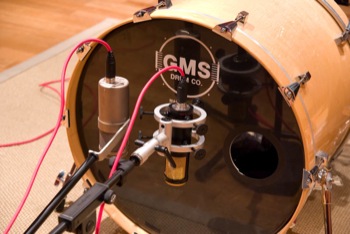 |
When recording the bass drums, we compared El Diablo with a Soundelux E47, strongly inspired by a Neumann U47. Mics were put in front of the bass drum.
The first recorded BD was a 22” maple GMS. This modern bass drum is ideal for rock, with its round and punchy tone. The El Diablo performs well and the mic’s SPL handling capability is very good. Compared to the E47, the El Diablo delivered a more complete sound: you can hear everything, from the beater transients to the “boom.”
We were in a cold sweat about our first extreme test : putting the El Diablo inside the kick, through the event… But there was no problem, not an ounce of saturation, the sound was still perfectly clear. Admittedly it had a lot af bottom end, and was less interesting than when the mic was in front of the bass drum, but Crowley & Tripp have taken up the technological challenge.
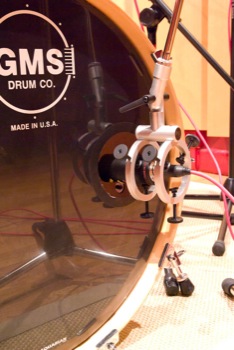 |
The second BD is a 24” birch Mapex. Huge kick, lots of bottom end. In this context, brillance isn’t that important and El Diablo has no particular interest. There’s too much low end, when the E47 does a better job of keeping the balance between beater and “boom”.
The last BD was a Gretsch 1964 Vintage 22" birch bass drum. Of course, the sound was… vintage. The El Diablo did a good job, but sounded better when used on the modern BD. Here is the E47 on the Gretsch bass drum.
The conclusion to the first part of this review, is that the El Diablo is a demanding mic. It is at its best when used on modern bass drums with round and balanced sound. It perfectly emphasizes their sonic qualities and brings lots of possibilities for mixing.
We added an audio example of a Slingerland snare drum. El Diablo delivered a very large but dull sound. Hence the necessity of a second mic if you want to capture the snare’s high frequencies. Here is the same snare drum mic’ed with a SM57.
Some bass
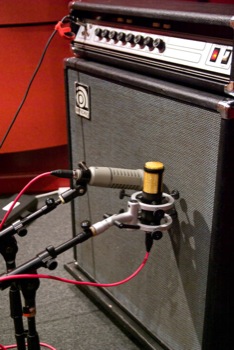 |
Before starting another benchmark, let’s say thanks to the wonderful backline of Studio de la Reine. For our bass amp test, we had nothing less than a mint all-tubes Ampeg B40 with its 4×10” cabinet… And the bass was a 1968 Fender Precision.
The extreme SPL handling capability of the El Diablo allowed us to make recordings at a very loud level, way over what is usually acceptable by any ribbon mic. Especially when it was so close to the speaker. We set up the El Diablo beside microphones usually used in such an application but using different technologies, such as an Electro-Voice RE20.
When we listened back to the tracks, it was obvious that the El Diablo put the bass frequencies forward: the Fender was sounding very “boomy”. It was an ideal sound for dub, reggae or trip hop, but definitely not for metal. You may not like it, but I do. Here is the same bass and amp, mic’ed with a RE20. Then a slap part with the El Diablo, and with RE20.
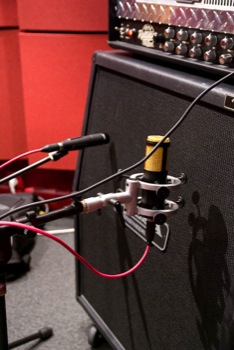 |
Guitar Amp
In order to record some guitar sounds, especially saturated sounds, we used a standard guitar and amp configuration: a Mesa Boogie Dual Rectifier and a 92 Gibson Les Paul Classic. We turned the volume all the way up and let the amp roar and howl. Usually, a SM57 is the ideal tool for that kind of sound. Of course, its behavior has nothing to do with ribbon mic behavior, but it’s a reference, and as such we’ve also recorded some takes with it.
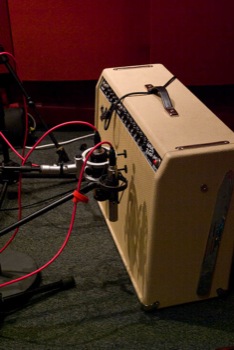 |
We must say that El Diablo does one hell of a job! The sound is big, fat and well-defined. You will have a lot of sonic textures to tailor, which could seems like too much when recording, but is perfect when mixing. Here is the recording done with the SM57.
The El Diablo also gives good results when recording clean sounds. We compared it with another ribbon mic, a Royer R-121, whose characteristics are relatively similar. The El Diablo delivers a balanced, natural bottom-end, very close to that of the R-121, but it gives a bit more high end, in the way a condenser mic would do.
In conclusion
To make a review in such conditions allowed us to appreciate all of the El Diablo’s potential, and we can’t say we were disappointed at all. On the technical side, it keeps all its promises, particularly regarding extreme SPL handling capability. Also it can be used in any given application, without fear of damaging it.The El Diablo has a real sonic personality, delivering a lot of bottom end. But it also has nice high end, more than the majority of ribbon microphones. It captures a large range of frequencies, giving the mix engineer enough textures to have several mixing choices.
It can effectively be an alternative to consider, instead of usual mics that aren’t used to being challenged in the high SPL domain.
Of course, innovation has its price, US SRP $2750 including a wood case and a suspension. It is more expensive than the majority of its direct competitors, from which we can conclude that only a privileged few will be able to use it in front of a bass drum or in any other application.
[+] Ultra-high SPL handling capability
[+] Capable of way more than other ribbon mics
[+] Sound
[-] Innovation has its price
Translation by sleepless
